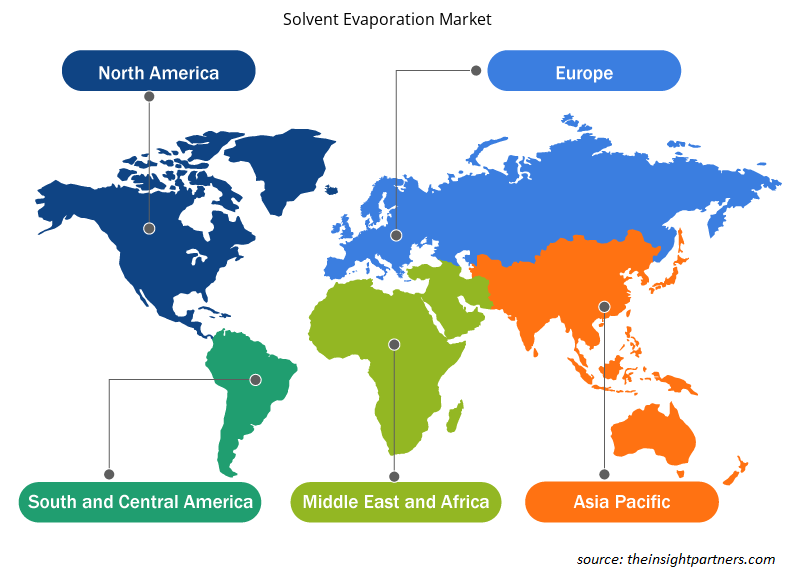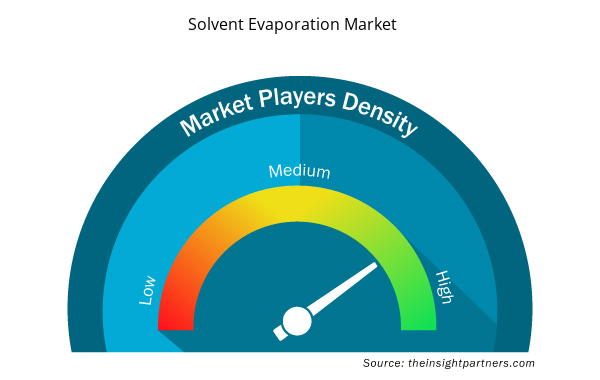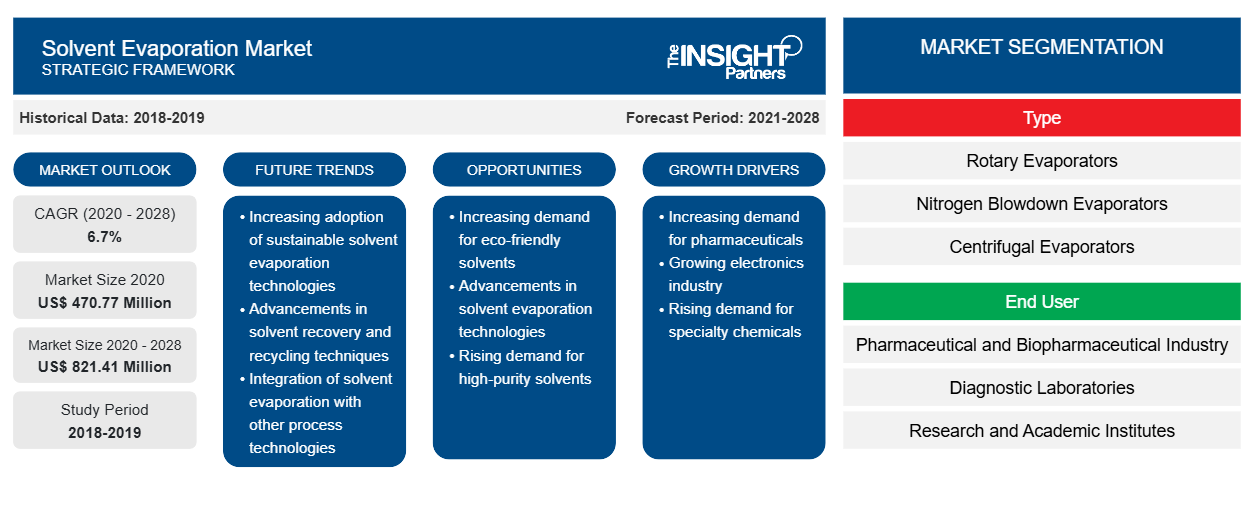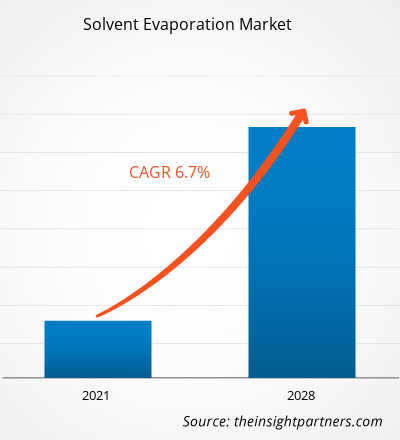Il mercato dell'evaporazione dei solventi è stato valutato a 470,77 milioni di dollari nel 2020 e si prevede che raggiungerà gli 821,41 milioni di dollari entro il 2028; si prevede una crescita a un CAGR del 6,7% nel periodo 2021-2028.CAGR of 6.7% during 2021–2028.
L'evaporazione del solvente comporta l'emulsione del polimero in fase acquosa e la dispersione in un solvente volatile come diclorometano, cloroformio e acetato di etile. Quindi il solvente viene evaporato utilizzando alte temperature, vuoto o agitazione continua. La dimensione delle particelle può essere controllata regolando parametri come la manipolazione della temperatura di evaporazione, il controllo della velocità di evaporazione, la manipolazione della velocità di agitazione, ecc. Questo metodo viene praticato per le nanoparticelle sviluppate utilizzando rispettivi polimeri come PLA, PLGA, PCL, poliidrossibutirrato, ecc. caricati con vari farmaci come tossoide tetanico, testosterone, loperamide, ciclosporina A e indometacina. Gli evaporatori di solvente sono ampiamente utilizzati in processi come la microincapsulazione e sono necessari per preparare nanoparticelle polimeriche per varie formulazioni farmaceutiche. I progressi tecnologici nei sistemi di evaporazione del solvente, come la concentrazione centrifuga, la liofilizzazione e le trappole fredde ad alta potenza, hanno portato a una migliore evaporazione e a un migliore recupero del solvente, con un impatto ambientale minore.
Fattori quali l'aumento della spesa in R&S, il crescente sviluppo di biofarmaci a grandi molecole, la crescente domanda di campioni puri nei mercati di utilizzo finale guidano la crescita del mercato dell'evaporazione del solvente. Tuttavia, le imprecisioni nei risultati e lo spreco di risorse dovuto al disagio associato all'evaporazione del solvente ostacolano la crescita del mercato dell'evaporazione del solvente .biopharmaceuticals, surging demand for pure samples in end-use markets drive the growth of the solvent evaporation market. However, inaccuracies in results and wastage of resources due to uneasiness associated with solvent evaporation hinder the
Personalizza questo report in base alle tue esigenze
Riceverai la personalizzazione gratuita di qualsiasi report, comprese parti di questo report, o analisi a livello nazionale, pacchetto dati Excel, oltre a usufruire di grandi offerte e sconti per start-up e università
- Scopri le principali tendenze di mercato in questo rapporto.Questo campione GRATUITO includerà analisi di dati che spaziano dalle tendenze di mercato alle stime e alle previsioni.
Approfondimenti di mercato
Aumento della spesa in R&S nel settore farmaceutico
Le sostanze attive dell'evaporazione del solvente sono un passaggio essenziale nel processo di scoperta dei farmaci, in quanto vengono utilizzate in fasi quali sintesi, preparazione del campione e riciclaggio del solvente, nonché nell'aumento della produzione di nuove terapie. Molte aziende farmaceutiche investono enormi quantità nel processo di ricerca e sviluppo (R&S) che ruota principalmente attorno alla scoperta e allo sviluppo di molecole innovative. Secondo un rapporto pubblicato su Statista, la spesa globale per la R&S farmaceutica è stata di circa 181 miliardi di $ nel 2018 e si prevede che raggiungerà i 223 miliardi di $ entro il 2026. Secondo l'India Brand Equity Foundation, le aziende farmaceutiche indiane hanno investito circa il 7,0% dei loro ricavi nel processo di R&S nel 2015 e gli investimenti in R&S sono cresciuti dell'8,6% nel 2019. Pertanto, l'aumento della spesa in R&S sta alimentando la crescita del mercato dell'evaporazione del solvente.Statista, the global spending on pharmaceutical R&D totaled US$ ~181 billion in 2018, and it expected to reach US$ 223 billion by 2026. As per the India Brand Equity Foundation, Indian pharmaceutical companies invested ~7.0% of their revenues in the R&D process in 2015 and R&D investment grew by 8.6% in 2019. Thus, increasing R&D expenditure is fueling the growth of the solvent evaporation market.
Informazioni basate sul tipo
In base al tipo, il mercato dell'evaporazione del solvente è segmentato in evaporatori rotanti, evaporatori a blowdown di azoto, evaporatori centrifughi ed evaporatori a flusso d'aria a spirale. Il segmento degli evaporatori rotanti ha detenuto la quota maggiore del mercato nel 2020. Tuttavia, si stima che il segmento degli evaporatori a blowdown di azoto registrerà il CAGR più elevato del 7,4% nel mercato durante il periodo di previsione. L'evaporatore rotante svolge un ruolo importante nell'estrazione efficiente del solvente tramite evaporazione, che è un passaggio importante nello sviluppo di campioni puri in diversi settori. Fattori come l'aumento delle spese di R&S e diversi vantaggi associati a questa tecnica stanno spingendo la crescita del mercato dell'evaporazione del solvente.blowdown evaporators, centrifugal evaporators, and spiral air flow evaporators. The rotary evaporators segment held the largest share of the market in 2020. However, the nitrogen blowdown evaporators segment is estimated to register the highest CAGR of 7.4% in the market during the forecast period. The rotary evaporator plays a major role in efficient extraction of solvent through evaporation which is an important step in developing pure samples in several industries. The factors such as increasing R&D expenditures and several benefits associated with this technique are propelling the growth of the solvent evaporation market.
Informazioni basate sull'utente finale
In base all'utente finale, il mercato dell'evaporazione del solvente è segmentato in industria farmaceutica e biofarmaceutica, laboratori diagnostici e istituti di ricerca e accademici. Il segmento dell'industria farmaceutica e biofarmaceutica ha detenuto la quota maggiore del mercato nel 2020. Tuttavia, si stima che il segmento degli istituti di ricerca e accademici registrerà il CAGR più elevato del 7,7% nel mercato durante il periodo di previsione, a causa di fattori quali l'aumento degli studi sullo sviluppo di farmaci e la crescente domanda di innovazione continua e miglioramento dei prodotti esistenti.biopharmaceutical industry, diagnostic laboratories, and research and academic institutes. The pharmaceutical and biopharmaceutical industry segment held the largest share of the market in 2020. However, the research & academic institutes segment is estimated to register the highest CAGR of 7.7% in the market during the forecast period. due to factors such as increasing drug development studies and rising demand for continuous innovation and enhancement of existing products.
Diverse aziende che operano nel mercato dell'evaporazione dei solventi utilizzano strategie quali lanci di prodotti, fusioni e acquisizioni, collaborazioni, innovazioni di prodotto ed espansioni del portafoglio prodotti per espandere la propria presenza in tutto il mondo, mantenere il marchio e soddisfare la crescente domanda degli utenti finali.
Approfondimenti regionali sul mercato dell'evaporazione dei solventi
Le tendenze regionali e i fattori che influenzano il mercato dell'evaporazione dei solventi durante il periodo di previsione sono stati ampiamente spiegati dagli analisti di Insight Partners. Questa sezione discute anche i segmenti e la geografia del mercato dell'evaporazione dei solventi in Nord America, Europa, Asia Pacifico, Medio Oriente e Africa e Sud e Centro America.

- Ottieni i dati specifici regionali per il mercato dell'evaporazione dei solventi
Ambito del rapporto di mercato sull'evaporazione del solvente
| Attributo del report | Dettagli |
|---|---|
| Dimensioni del mercato nel 2020 | 470,77 milioni di dollari USA |
| Dimensioni del mercato entro il 2028 | 821,41 milioni di dollari USA |
| CAGR globale (2020 - 2028) | 6,7% |
| Dati storici | 2018-2019 |
| Periodo di previsione | 2021-2028 |
| Segmenti coperti | Per tipo
|
| Regioni e Paesi coperti | America del Nord
|
| Leader di mercato e profili aziendali chiave |
|
Attori del mercato dell'evaporazione del solvente Densità: comprendere il suo impatto sulle dinamiche aziendali
Il mercato dell'evaporazione dei solventi sta crescendo rapidamente, spinto dalla crescente domanda degli utenti finali dovuta a fattori quali l'evoluzione delle preferenze dei consumatori, i progressi tecnologici e una maggiore consapevolezza dei benefici del prodotto. Con l'aumento della domanda, le aziende stanno ampliando le loro offerte, innovando per soddisfare le esigenze dei consumatori e capitalizzando sulle tendenze emergenti, il che alimenta ulteriormente la crescita del mercato.
La densità degli operatori di mercato si riferisce alla distribuzione di aziende o società che operano in un particolare mercato o settore. Indica quanti concorrenti (operatori di mercato) sono presenti in un dato spazio di mercato in relazione alle sue dimensioni o al valore di mercato totale.
Le principali aziende che operano nel mercato dell'evaporazione dei solventi sono:
- BUCHI LABORTECHNIK AG
- BIOTAGGIO AB
- Società LABCONCO
- STRUMENTI HEIDOLPH GMBH & CO. KG
- YAMATO SCIENTIFIC CO., LTD.
Disclaimer : le aziende elencate sopra non sono classificate secondo un ordine particolare.

- Ottieni una panoramica dei principali attori del mercato dell'evaporazione dei solventi
Mercato dell'evaporazione del solvente - per tipo
- Evaporatori rotanti
- Evaporatori di scarico dell'azoto
- Evaporatori centrifughi
- Evaporatori a flusso d'aria a spirale
Mercato dell'evaporazione del solvente – per utente finale
- Industria farmaceutica e biofarmaceutica
- Laboratori Diagnostici
- Istituti di ricerca e accademici
Mercato dell'evaporazione del solvente – per area geografica
America del Nord
- NOI
- Canada
- Messico
Europa
- Francia
- Germania
- Italia
- Regno Unito
- Spagna
- Resto d'Europa
Asia Pacifico (APAC)
- Cina
- India
- Corea del Sud
- Giappone
- Australia
- Resto dell'Asia Pacifica
Medio Oriente e Africa (MEA)
- Sudafrica
- Arabia Saudita
- Emirati Arabi Uniti
- Resto del Medio Oriente e Africa
America del Sud (SAM)
- Brasile
- Argentina
- Resto del Sud e Centro America
Profili aziendali
- BUCHI LABORTECHNIK AG
- BIOTAGGIO AB
- Società LABCONCO
- STRUMENTI HEIDOLPH GMBH & CO. KG
- YAMATO SCIENTIFIC CO., LTD.
- Società a responsabilità limitata
- IKA WERKE GMBH E CO. KG
- STEROGLASS SRL
- SOCIETÀ ASSOCIATE PER ORGANIZZAZIONE, INC.
- KNF NEUBERGER, INC.
- RAYKOL
- PROGETTI ALBICOCCA, INC.
- LABTECH SRL
- MEZZALUNA SCIENTIFICA
- SCINCO CO., LTD
- Analisi storica (2 anni), anno base, previsione (7 anni) con CAGR
- Analisi PEST e SWOT
- Valore/volume delle dimensioni del mercato - Globale, regionale, nazionale
- Industria e panorama competitivo
- Set di dati Excel


- Malaria Treatment Market
- Transdermal Drug Delivery System Market
- Visualization and 3D Rendering Software Market
- Online Exam Proctoring Market
- Sports Technology Market
- Non-Emergency Medical Transportation Market
- Webbing Market
- Legal Case Management Software Market
- Joint Pain Injection Market
- Vessel Monitoring System Market

Report Coverage
Revenue forecast, Company Analysis, Industry landscape, Growth factors, and Trends

Segment Covered
This text is related
to segments covered.

Regional Scope
North America, Europe, Asia Pacific, Middle East & Africa, South & Central America

Country Scope
This text is related
to country scope.
Domande frequenti
Increasing R&D expenditure, a growing development of large-molecule biopharmaceuticals, increasing demand for pure samples in end use markets fuels the market growth and various technological advancements. As the solvent evaporation technique is widely used in sample preparation across pharmaceutical industries thus with the increasing use of this technology coupled with growing development in the novel drug is propelling the market.
Inaccuracies in results and wastage of resources due to uneasiness associated with solvent evaporation hinders the growth of the solvent evaporation market.
Solvent evaporation involves emulsification of polymer in aqueous phase and dispersion in a volatile solvent like dichloromethane, chloroform, and ethyl acetate. Then the solvent is evaporated using high temperature, vacuum, or by continuous stirring. Size of the particles can be controlled by adjusting parameters like manipulating evaporation temperature, controlling the rate of evaporation, manipulating stirring rate, etc. This method is being practiced for the nanoparticles developed using respective polymers such as, PLA, PLGA, PCL, polyhydroxybutyrate, etc. loaded with various drugs like tetanus toxoid, testosterone, loperamide, cyclosporin A, and indomethacin. Solvent evaporators are widely used in processes such as microencapsulation and are required to prepare polymeric nanoparticles for various pharmaceutical formulations. Technological advancements in solvent evaporation systems, such as centrifugal concentration, freeze-drying, and high-power cold traps, have led to enhanced evaporation and improved solvent recovery, with lesser environmental impact.
Trends and growth analysis reports related to Life Sciences : READ MORE..
The List of Companies - Solvent Evaporation Market
- BUCHI LABORTECHNIK AG
- BIOTAGE AB
- LABCONCO CORPORATION
- HEIDOLPH INSTRUMENTS GMBH & CO. KG
- YAMATO SCIENTIFIC CO., LTD.
- PORVAIR PLC
- IKA WERKE GMBH AND CO. KG
- STEROGLASS SRL
- ORGANOMATION ASSOCIATES, INC.
- KNF NEUBERGER, INC.
- RAYKOL
- APRICOT DESIGNS, INC.
- LABTECH S.R.L.
- CRESCENT SCIENTIFIC
- SCINCO CO.,LTD
The Insight Partners performs research in 4 major stages: Data Collection & Secondary Research, Primary Research, Data Analysis and Data Triangulation & Final Review.
- Data Collection and Secondary Research:
As a market research and consulting firm operating from a decade, we have published and advised several client across the globe. First step for any study will start with an assessment of currently available data and insights from existing reports. Further, historical and current market information is collected from Investor Presentations, Annual Reports, SEC Filings, etc., and other information related to company’s performance and market positioning are gathered from Paid Databases (Factiva, Hoovers, and Reuters) and various other publications available in public domain.
Several associations trade associates, technical forums, institutes, societies and organization are accessed to gain technical as well as market related insights through their publications such as research papers, blogs and press releases related to the studies are referred to get cues about the market. Further, white papers, journals, magazines, and other news articles published in last 3 years are scrutinized and analyzed to understand the current market trends.
- Primary Research:
The primarily interview analysis comprise of data obtained from industry participants interview and answers to survey questions gathered by in-house primary team.
For primary research, interviews are conducted with industry experts/CEOs/Marketing Managers/VPs/Subject Matter Experts from both demand and supply side to get a 360-degree view of the market. The primary team conducts several interviews based on the complexity of the markets to understand the various market trends and dynamics which makes research more credible and precise.
A typical research interview fulfils the following functions:
- Provides first-hand information on the market size, market trends, growth trends, competitive landscape, and outlook
- Validates and strengthens in-house secondary research findings
- Develops the analysis team’s expertise and market understanding
Primary research involves email interactions and telephone interviews for each market, category, segment, and sub-segment across geographies. The participants who typically take part in such a process include, but are not limited to:
- Industry participants: VPs, business development managers, market intelligence managers and national sales managers
- Outside experts: Valuation experts, research analysts and key opinion leaders specializing in the electronics and semiconductor industry.
Below is the breakup of our primary respondents by company, designation, and region:

Once we receive the confirmation from primary research sources or primary respondents, we finalize the base year market estimation and forecast the data as per the macroeconomic and microeconomic factors assessed during data collection.
- Data Analysis:
Once data is validated through both secondary as well as primary respondents, we finalize the market estimations by hypothesis formulation and factor analysis at regional and country level.
- Macro-Economic Factor Analysis:
We analyse macroeconomic indicators such the gross domestic product (GDP), increase in the demand for goods and services across industries, technological advancement, regional economic growth, governmental policies, the influence of COVID-19, PEST analysis, and other aspects. This analysis aids in setting benchmarks for various nations/regions and approximating market splits. Additionally, the general trend of the aforementioned components aid in determining the market's development possibilities.
- Country Level Data:
Various factors that are especially aligned to the country are taken into account to determine the market size for a certain area and country, including the presence of vendors, such as headquarters and offices, the country's GDP, demand patterns, and industry growth. To comprehend the market dynamics for the nation, a number of growth variables, inhibitors, application areas, and current market trends are researched. The aforementioned elements aid in determining the country's overall market's growth potential.
- Company Profile:
The “Table of Contents” is formulated by listing and analyzing more than 25 - 30 companies operating in the market ecosystem across geographies. However, we profile only 10 companies as a standard practice in our syndicate reports. These 10 companies comprise leading, emerging, and regional players. Nonetheless, our analysis is not restricted to the 10 listed companies, we also analyze other companies present in the market to develop a holistic view and understand the prevailing trends. The “Company Profiles” section in the report covers key facts, business description, products & services, financial information, SWOT analysis, and key developments. The financial information presented is extracted from the annual reports and official documents of the publicly listed companies. Upon collecting the information for the sections of respective companies, we verify them via various primary sources and then compile the data in respective company profiles. The company level information helps us in deriving the base number as well as in forecasting the market size.
- Developing Base Number:
Aggregation of sales statistics (2020-2022) and macro-economic factor, and other secondary and primary research insights are utilized to arrive at base number and related market shares for 2022. The data gaps are identified in this step and relevant market data is analyzed, collected from paid primary interviews or databases. On finalizing the base year market size, forecasts are developed on the basis of macro-economic, industry and market growth factors and company level analysis.
- Data Triangulation and Final Review:
The market findings and base year market size calculations are validated from supply as well as demand side. Demand side validations are based on macro-economic factor analysis and benchmarks for respective regions and countries. In case of supply side validations, revenues of major companies are estimated (in case not available) based on industry benchmark, approximate number of employees, product portfolio, and primary interviews revenues are gathered. Further revenue from target product/service segment is assessed to avoid overshooting of market statistics. In case of heavy deviations between supply and demand side values, all thes steps are repeated to achieve synchronization.
We follow an iterative model, wherein we share our research findings with Subject Matter Experts (SME’s) and Key Opinion Leaders (KOLs) until consensus view of the market is not formulated – this model negates any drastic deviation in the opinions of experts. Only validated and universally acceptable research findings are quoted in our reports.
We have important check points that we use to validate our research findings – which we call – data triangulation, where we validate the information, we generate from secondary sources with primary interviews and then we re-validate with our internal data bases and Subject matter experts. This comprehensive model enables us to deliver high quality, reliable data in shortest possible time.


 Ottieni un campione gratuito per questo repot
Ottieni un campione gratuito per questo repot